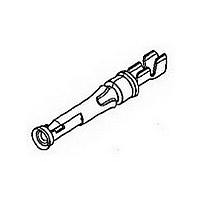1-66109-8 TE Connectivity, 1-66109-8 Datasheet - Page 3

1-66109-8
Manufacturer Part Number
1-66109-8
Description
CONTACT, SOCKET, 26-24AWG, CRIMP
Manufacturer
TE Connectivity
Type
Contactr
Series
Type III+r
Datasheet
1.1-66109-8.pdf
(58 pages)
Specifications of 1-66109-8
Gender
SKT
Body Orientation
Straight
Housing Material
Not Required
Number Of Contacts
1POS
Number Of Ports
1Port
Number Of Terminals
1
Pitch (mm)
Not Requiredmm
Contact Material
Brass
Mounting Style
Cable
Termination Method
Crimp
Contact Plating
Tin Over Nickel
Connector Type
Contact, Crimp
Current Rating
13A
Contact Termination
Crimp
Rohs Compliant
Yes
Contact Gender
Socket
Lead Free Status / RoHS Status
Compliant
For Use With
G Series, M Series, CPC Connectors
4
Current Rating
Ve r i f i c a t i o n
Catalog 82045
Revised 11-03
www.tycoelectronics.com
Dimensions are in millimeters
and inches unless otherwise
specified. Values in brackets are
equivalent U.S. Customary Units.
Metrimate Pin and Socket Connectors
Performance Characteristics
Can a contact rated at
10 amperes carry 10 amperes?
Maybe yes, but probably
not. The reason lies in the
test conditions used to rate
the contact. If these conditions
do not adequately reflect
the application conditions,
the actual allowable current
levels may be lower than
specified levels. For exam-
ple, many manufacturers,
including Tyco Electronics,
test a single contact in air.
This gives an accurate
measure of the basic cur-
rent-carrying capacity of the
contact. Use the contact
alone in air and it can cer-
tainly carry 10 amperes.
Use it in a multi-position
connector surrounded by
other current-carrying
contacts or in high ambient
temperatures, and the
contact should carry less
current.
Similarly, as the contact
ages and stress relaxation,
environmental cycling, and
other degradation factors
take their toll, the contact’s
current-carrying capacity
decreases. A prudent
design must set current lev-
els for such end-of-design-
life (EODL) conditions.
Practical current-carrying
capacity is not an absolute,
but an application-depen-
dent condition.
New Method Simplifies
R a t i n g s
To help the designer set the
appropriate current level,
Tyco Electronics has devel-
oped a method of specify-
ing current-carrying
capacity. This method takes
into account the various
application factors that
influence current rating.
Dimensions are shown for
reference purposes only.
Specifications subject
to change.
The method can be
summarized as follows:
Te m p e r a t u r e
One other factor influencing
current levels is the maxi-
mum operating tempera-
ture, for example, 105°C. If
the application has a high
ambient temperature (over
75°C) the contact’s T-rise is
limited by the maximum
operating temperature. For
example, an application
temperature of 90°C limits
the contact T-rise to 15°C.
Since current produces
heat (the I
rent must be lowered to limit
the T-rise.
A contact’s T-rise depends
not only on its I
heating, but also on its abil-
ity to dissipate the heat.
Consider a contact in a
multi-contact housing. Joule
heating in multiple contacts
will raise the local ambient
temperature. Since the con-
tact will not be able to dissi-
pate its own heat as well by
convection, the maximum
T-rise will be realized at a
lower current level. Conse-
quently, the allowable cur-
rent level must be lower to
maintain an acceptable
T-rise.
The contact is aged to
EODL conditions by dura-
bility cycling, thermal
cycling, and environmen-
tal exposure.
The contact’s resistance
stability is verified.
The current necessary to
produce the specified
temperature rise is mea-
sured. This T-rise is usu-
ally 30°C.
A rating factor is deter-
mined to allow derating of
multiple contacts in the
same housing and for dif-
ferent conductor sizes.
( C o n t i n u e d )
USA: 1-800-522-6752
Canada: 1-905-470-4425
Mexico: 01-800-733-8926
C. America: 52-55-5-729-0425
2
R law), the cur-
2
R Joule
For a given connector, the
current level will be set by
the loading density. A con-
nector containing 50% cur-
rent-carrying contacts will
permit higher currents (per
contact) than a connector
will at 75% loading. The
loading percentage
assumes an even distribu-
tion of contacts within the
housing. If all 10 contacts
are grouped together in one
section of a 20-position
connector, the loading den-
sity may approach 100%.
The Importance of EODL
As stated, T-rise in a contact
depends on both resistance
and current. As it ages, a
contact’s resistance will
increase. The contact
designer will specify a maxi-
mum resistance for the con-
tact, this level is the
end-of-design-life resis-
tance. Before the contact is
tested for current, Tyco
Electronics subjects it to a
sequence of tests that exer-
cise many major failure
mechanisms and thereby
simulates EODL conditions.
Conditioning includes mat-
ing cycling, industrial
mixed-flowing gases,
humidity and temperature
cycling, and vibration to
sequentially introduce wear,
corrosion, stress relaxation,
and mechanical distur-
bance.
P r e s e n t a t i o n
The presentation of current-
carrying capacity in Tyco
Electronics product specifi-
cations includes two parts:
First, a base curve show-
ing current levels versus
T-rise for a single circuit
and the largest wire size.
This represents the maxi-
mum current capacity of
South America: 55-11-3611-1514
Hong Kong: 852-2735-1628
Japan: 81-44-844-8013
UK: 44-141-810-8967
4

























